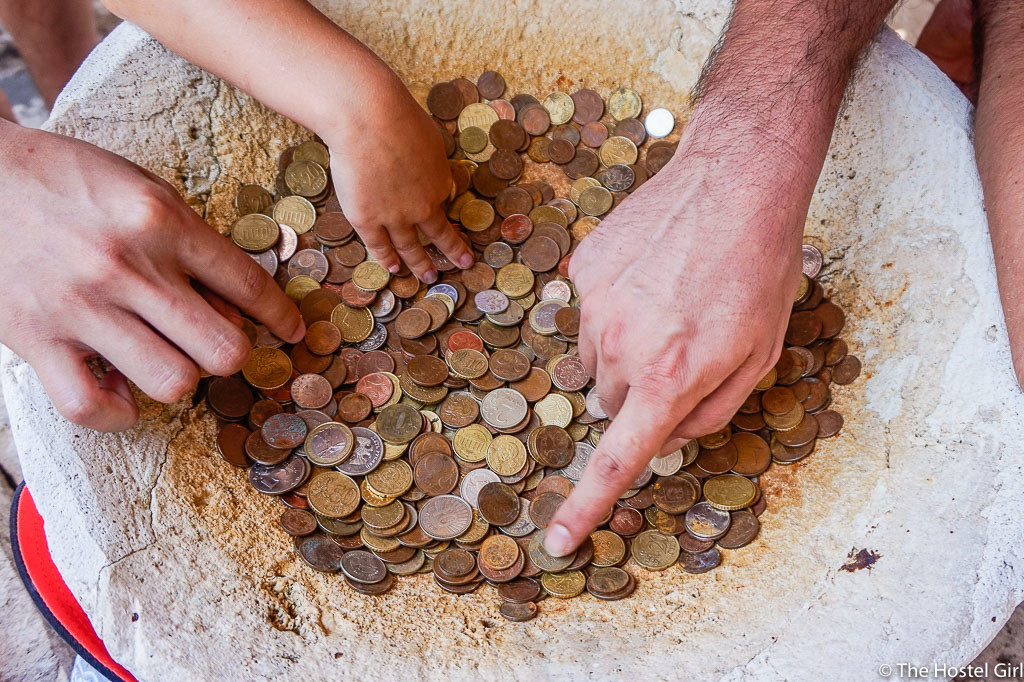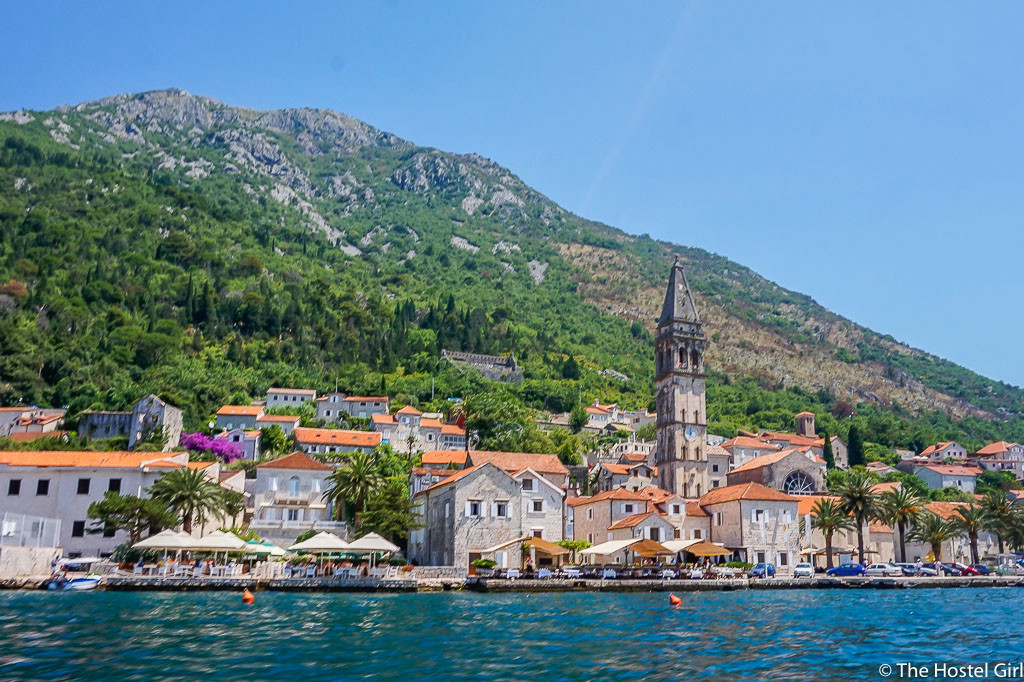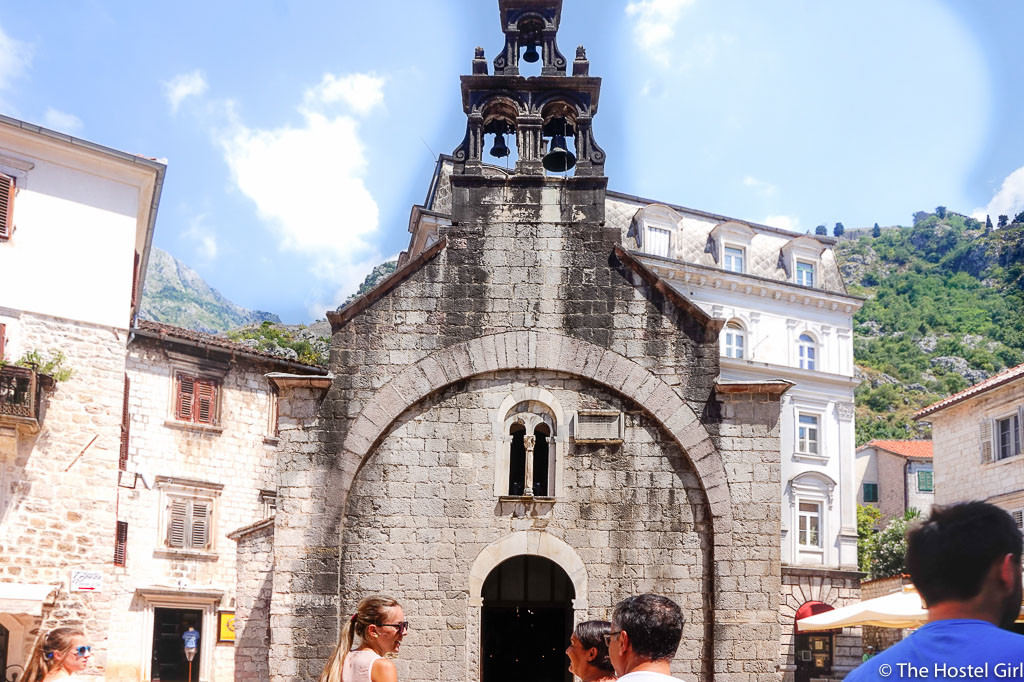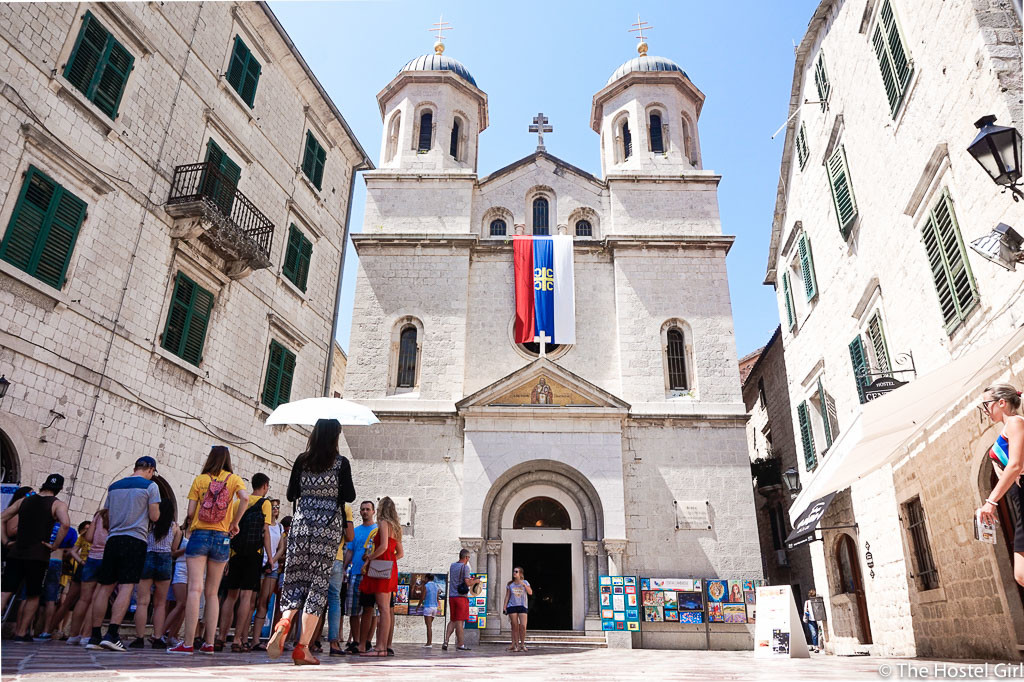As I waited for Gojko outside Old Town Hostel Kotor, I began to get excited for my upcoming private tour of Perast and Kotor. I love taking tours (click here to see previous tour reviews), especially when they’re led by locals with a passion for their city’s culture and history.
But, this was the first time I’d ever taken a private tour. With a guide just for me. And it began with a stunning 9am boat ride in the Bay of Kotor, just as the first rays of sunshine were sneaking over the mountainous peaks that surround the bay…

Our first stop was to the Church of Our Lady of the Rocks – read about the curious legend of Gospa od Skrpjela here. And it’s here that I’m going to share the first secret I learned from Gojko…
International Pennies in Perast
It’s easy to miss, and at first glance you may not think it very important, but at the back of the Church of Our Lady of the Rocks stands a small stone bowl. It looks almost like a baptism bowl, except that it holds coins instead of holy water.
The coins are donations, left by visitors and pilgrims to the church. The beauty of it lies in the fact that it’s a reminder of just how revered the island is from all over the globe.
So as Gojko and I thumbed through the coins to see where they originated from my most used question was “where is this one from?” Make sure to see how many countries you can identify when you visit!

After counting (and putting back!) the pennies we hopped back into the boat. And as the skipper effortlessly sped the boat past the Venetian settlements that line the bay, Gojko continued sharing the history of his country.
The history, as told by a born and bred Montenegrin, was one of the most fascinating parts of my trip to Kotor. I had tried my very best to read as much as I could about the country before I arrived, but aside from this complicated but detailed book by Francis Seymour Stevenson there was little I could find!

Which is a shame because, along with the intricate legends and wonderful people that live amongst the mountains and coastline, Montenegro’s history is rich with golden age periods and influential change-makers.
Which brings me to my second secret…
Notable Citizens of Perast
Dwarfed by the hill of St. Ilija that stands behind it, Perast appears small. Yet as you approach by boat the impressive bell tower and many Venetian palaces begin to rise up and hint at its influential role in the history of the Adriatic coast.

A view of Perast from the Bay of Kotor
Perast’s influence during the 17th and 18th centuries is overwhelming, and much of it has to do with the three men below.
Tripo Kokolja was born in Perast but went on to study painting in Venice before painting all of the frescos within the Church of Our Lady of the Rocks. Marko Martinovic commanded the education of Russian cadets at the appointment of Tsar Peter the Great and went on to open the first maritime school in Perast in 1700, no doubt contributing to the impressive fleet of ships that ran from Perast for the following two centuries. And last but not least, Matija Zmajevic served as an Admiral in Tsar Peter the Great’s Russian Baltic Fleet!
Incredibly, none of them lived past 55 years of age, but here in Perast they are immortalised in stone.
After getting to know these three guys and learn in more detail about how their contribution helped make Perast known on a global scale, Gojko and I stopped for a quick coffee.
Well, the intention was to stop for quick coffee. But we sat for at least 45 minutes just chatting about our lives and family history. Gojko is so easy to chat with and makes not only a great guide, but a great coffee date! This was one of my favourite things about spending the day with a private guide to Kotor. The fact that if I wanted to slow down to take more photos, or had specific questions, or wanted to visit something in particular – Gojko could make it happen.
But soon it was time to return by boat to Kotor for the second part of the private tour, and the third secret I’m going to share with you…

The Leaning Clock Tower of Kotor
My private tour around the Bay of Kotor took place on my second day in Montenegro, and by this time I had taken two evening and early morning walks past the clock tower in the main square.
But I had never noticed that the tower is leaning!
Since the clock tower’s original construction in 1602, it has suffered through multiple earthquakes and its leaning facade serves as a reminder of these natural tragedies.

The clock tower first began to lean after the 1667 earthquake. During the same event, over 5,000 residents of Dubrovnik (two hours North West of Kotor) were reported as dead.
In the 300 years following this event, attempts had been made to re-align the tower. But it’s tilt to the West was secured in 1979, when the most recent destructive earthquake to hit Kotor took place and simultaneously damaged the majority of the old town centre.

Oh, and the clock still works! But I’ll let Gojko tell you how that’s possible when you meet him for your very own private tour…!
From there we wondered further into the old town that I had begun to call home after just two days (have you figured out yet that I fell in love with Montenegro?).
And despite unearthing so many more secrets about the historic town, I’m going to leave you with the one I found most interesting.
The Sealed Tombs of Sveti Luka
Sveti Luka (or St Luke’s) has been dwarfed by the more modern church of Sveti Nikola (St. Nicolas) that was built in 1908. But, the tiny chapel is significant for holding two historic secrets.
The first is that despite originally being built as a Catholic Church in 1195, it held within it’s nave both a Catholic and Orthodox alter between 1657 and 1812. For those 155 years, the two faiths worshipped in the stunning chapel side by side, in a manner that many religions could learn from today…

As we entered, Gojko motioned towards the floor and it was then that I first noticed the sealed tombs that lay beneath our feet.
“Why do you think they are sealed?” he asked me.
Which was the totally wrong question to ask someone who reads too much historic vampire folklore.
“Because they thought they were vampires?”
Gojko gave me his best ‘are you serious?’ face while I cringed at what I’d said – it was literally the first thing to pop into my head!
It turns out, the old Montenegrins didn’t seal the tombs in Sveti Luka because they thought the deceased would escape as vampires. They sealed them as those buried within died from a deadly plague that they believed would spread on after death…

And if you didn’t notice, the chapel of Sveti Luka is beautiful and well worth visiting.
As is the Church of Sveti Nikola. The contrast between these two churches that stand almost opposite each other within the walls of Old Town Kotor is magnificent. But Sveti Luka is definitely my favourite – if you visit let me know which one you prefer!

How to book your Kotor Private Guide
If you can’t tell already, I had a great day out with Gojko. Not just because he really brings the history of the Bay of Kotor to life, but because he’s full of interesting anecdotes about life in the Bay and a great conversationalist!
So if you’re willing to stretch your budget to really get to know Kotor and Perast and are considering taking a private guide, I couldn’t recommend him any higher!
To book with him, just visit his website KotorPrivateGuide.com or click the button below!

There’s so much more I learnt from Gojko that I still have to share (like the special tapestry inside the Church of Our Lady of the Rocks!), so keep an eye out over the coming weeks or sign up for my newsletter to be the first to hear about it.
I also have to give a huge thank you to Gojko of Kotor Private Guide, for taking the time to share his hometowns with me… and the coffee! I took the tour as a guest of the Tourism Organisation of Kotor but as always, opinions are honest and my own.




